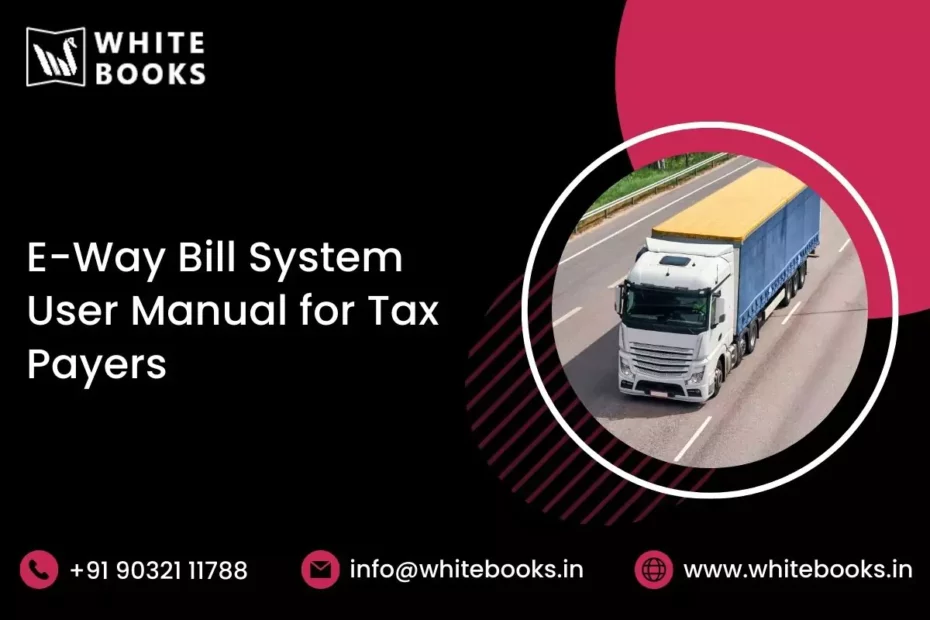Table of Contents
1. Introduction About e-Way Bill System
Implementing the Goods and Services Tax (GST) in India on July 1, 2017, was a major milestone in the country’s indirect tax reform. All check posts across the country were abolished to facilitate goods’ smooth and efficient movement. An ICT-based solution was deemed necessary to implement the e-Way Bill system, which serves as a document issued by the person responsible for transportation. As a result, the Goods and Services Tax (GST) Council approved the development of a web-based solution by the National Informatics Centre. This solution is now being rolled out for use by taxpayers and carriers.
1.1 Purpose and Intended Audience
The purpose of this document is to provide a comprehensive understanding of the operational procedure for using the web-based e-Way Bill System. It outlines the various functions of the e-Way Bill system and clarifies the roles of the stakeholders involved in the system.
The target audience for this document consists primarily of two groups:
Registered taxpayers:
Under the Goods and Services Tax (GST) system: these individuals or entities must generate and carry e-Way Bills to transport goods under GST regulations.
Unregistered transporters:
This group of stakeholders, who may not be registered under GST, also plays a crucial role in the e-Way Bill system. They need to understand their responsibilities and obligations related to transporting goods and the requirements of the e-Way Bill.
This document is intended to help registered taxpayers and non-registered carriers effectively use the web-based e-Way Bill system under GST by providing clear guidance on the e-Way Bill system and its features.
1.2 URL or Web site address
2. E-Way Bill System
2.1. e-Way Bill under the Earlier VAT system
Under the earlier Value Added Tax (VAT) system, a waybill or “Delivery Note” was required for monitoring bulk trade conducted through trucks. VAT offices issued the Delivery Notes to taxpayers, and at the end of each month, taxpayers had to submit a statement indicating the utilization of the issued forms. This requirement aimed to control tax evasion by certain taxpayers. However, obtaining blank Delivery Notes posed challenges for taxpayers as they had to make multiple visits to the tax office. Additionally, trucks would often face lengthy delays at check-posts for arbitrary reasons, creating difficulties for both the trade and government.
To address these issues, a new idea/system was introduced. Under this system, taxpayers could upload transaction details to a departmental server online. Once uploaded, the server automatically generates a Delivery Note with a unique number. This unique number could accompany the goods vehicle as proof of the uploaded transaction. This system effectively prevented tax evasion since issuing a Delivery Note ensured transparency. It proved to be a successful and efficient method of combating tax evasion while also serving as an e-governance initiative, providing speedy and efficient services to taxpayers. Several states adopted and implemented this system.
2.2. e-Way Bill System under GST
Under the Goods and Services Tax (GST) system, the Unique Selling Proposition (USP) is “One Nation, One Tax, One Market.” However, implementing a separate waybill for each State under GST would complicate compliance and negatively impact the business of taxpayers and transporters. Such a system of separate e-Way Bills for each State would create obstacles to the movement of goods and hinder free trade between states. It would also pose challenges for State and central government officers to cross-verify independently generated e-Way Bills from each State.
To address this, a new process was required. The solution involved taxpayers informing the tax department about the details of each transaction before the movement of goods via a conveyance. Upon providing this information, the taxpayer would obtain an acknowledgment number to accompany the truck as a valid document. The concept was to have taxpayers upload transaction details to a common online portal. Once uploaded, the common portal would automatically generate a document that all stakeholders could easily track and verify.
This approach ensures a streamlined and efficient process, allowing for easy monitoring and verification of goods movement while maintaining the “One Nation, One Tax, One Market” goal under GST.
E-Way Bill in GST Rule
Under the e-Way Bill system in GST, the following rules and provisions apply:
- Before the commencement of the movement of goods and the generation of the e-Way Bill, every registered person must furnish the necessary information.
- Once the e-Way Bill is generated on the common portal, a unique e-Way Bill number (EBN) is available to the supplier, recipient, and transporter.
- The person in charge of the conveyance must carry the invoice or Bill of supply or delivery challan and a copy of the e-Way Bill or the e-Way Bill number.
- If registered, the recipient can access the details of the e-Way Bill generated on the common portal. They can communicate their acceptance or rejection of the consignment covered by the e-Way Bill.
- The information provided while generating the e-Way Bill, such as GSTIN of the recipient, place of delivery, invoice number, invoice date, the value of goods, HSN code, etc., is made available to the registered supplier on the common portal. The supplier can utilize this information for furnishing details in FORM GSTR-1.
- Authorized officers of the State have the authority to intercept any conveyance to verify the e-Way Bill or the e-Way Bill number in physical form for inter-State and intra-State movement of goods.
- A summary report of every inspection of goods in transit must be recorded online by the proper officer in a specified format within twenty-four hours of the inspection. The final report in a specified format must be recorded within three days of the inspection.
- Suppose a vehicle is intercepted and detained for a period exceeding thirty minutes. In that case, the transporter can upload the relevant information in a specified format on the common portal.
These rules and provisions ensure proper documentation, verification, and reporting of the e-Way Bill system, promoting transparency and compliance in the movement of goods under GST.
2.3. Objectives
The e-Way Bill system in GST is designed to achieve the following objectives:
- Single e-Way Bill for the movement of goods throughout the country: The system aims to establish a unified e-Way Bill that can be used for the movement of goods across all states in India. This eliminates the need for separate waybills for each State, simplifying compliance for taxpayers and transporters.
- Preventing tax evasion: The e-Way Bill system serves as a mechanism to curb tax evasion. By mandating the generation of e-Way Bills and providing a digital trail of goods movement, it becomes difficult for taxpayers to evade taxes or engage in fraudulent practices.
- Hassle-free movement across India: The system seeks to facilitate the smooth and seamless movement of goods across the country. By eliminating the need for physical check-posts, the e-Way Bill system reduces delays and ensures the efficient transportation of goods.
- Tracking the movement of goods with e-Way Bill number: Each generated e-Way Bill is assigned a unique identification number. This enables the tracking and monitoring of goods during transit, allowing relevant stakeholders to have visibility and control over the movement of goods.
- Easier verification of the e-Way Bill by officers: The e-Way Bill system provides a streamlined process for officers to verify the validity and authenticity of e-Way Bills. This simplifies the verification process and enables officers to enforce tax compliance measures effectively.
Overall, the objectives of the e-Way Bill system include the following:
- Promoting transparency.
- Reducing tax evasion.
- Enhancing the ease of doing business.
- Ensuring the efficient movement of goods across India.
2.4 Stakeholders
The e-Way Bill system in GST involves the active participation of various stakeholders. These stakeholders include:
- Suppliers: Suppliers play a crucial role in the e-Way Bill system. They are responsible for generating e-Way Bills for the movement of goods. They also have the authority to reject e-Way Bills generated by other parties if they do not pertain to their transactions.
- Recipients: Recipients of goods also have a role in the e-Way Bill system. They must generate e-Way Bills when they are the recipients of goods being transported. Like suppliers, recipients have the authority to reject e-Way Bills generated by others if they are irrelevant to their transactions.
- Transporters: Transporters play a significant role in the e-Way Bill system. They are responsible for generating e-Way Bills and consolidated e-Way Bills. Transporters also update the vehicle numbers associated with the e-Way Bills assigned to them for transportation by the taxpayers.
- Department Officers: Department officers are responsible for verifying e-Way Bills and the corresponding consignments being transported. They ensure compliance with the e-Way Bill requirements and conduct inspections to verify the accuracy and authenticity of the e-Way Bills and the goods being transported.
These stakeholders collectively contribute to the effective implementation and functioning of the e-Way Bill system. Their active involvement and collaboration ensure the smooth movement of goods, prevent tax evasion and maintain transparency in the GST framework.
2.5 Benefits of the e-Way Bill System
Implementing the e-Way Bill system brings several benefits to the stakeholders and the overall business environment. The major benefits include:
- Elimination of physical visits to tax offices: Under the e-Way Bill system, traders no longer need to visit tax offices to collect and submit physical ay Bill forms, as was the case under the VAT regimes in some states. This saves time and reduces administrative burdens for traders.
- Reduction in waiting time at mobile squads: The verification of e-Way Bills is done through the common portal, significantly speeding up the verification process. As a result, the average waiting time at mobile squads decreases, allowing vehicles to pass through faster and ensuring smoother transportation of goods.
- Self-policing by traders: The e-Way Bill system encourages self-policing by traders. When uploading transaction details, traders provide identification of the buying trader, which automatically accounts for the transaction. This promotes transparency and accountability in business transactions.
- Environmental friendliness: The e-Way Bill system eliminates the need for paper-based way bills, reducing paper consumption. This environmentally friendly approach saves tons of paper daily, contributing to sustainability efforts.
- Simplified generation of GSTR-1 returns: The e-Way Bill system automatically prepares the GSTR-1 return of the supplier. This eliminates the need for the supplier to separately upload the same information, streamlining the process and reducing duplication of efforts.
- Reduction in manual work for officials: The e-Way Bill system saves officials from collecting and matching manual e-Way bills with taxpayers’ tax returns. Automation and digitization simplify the process, allowing officials to focus on other critical tasks and improving overall efficiency.
These benefits collectively enhance operational efficiency, transparency, and compliance, making the e-Way Bill system a valuable tool in the GST framework.
2.6 Following are the enhancements in e-Way Bill System:
The e-Way Bill system has undergone various enhancements to improve its functionality and provide a better user experience. Some of the key enhancements include:
- Auto calculation of distance: The e-Way Bill system now automatically calculates the distance between the source and destination based on the PIN codes entered. This simplifies the process of generating e-Way Bills by eliminating the need for manual distance calculation.
- Blocking multiple e-Way Bills on one Invoice/Document: To prevent duplication and misuse, the system now blocks the generation of multiple e-Way Bills for a single invoice or document. This ensures that each invoice/document is associated with a unique e-Way Bill, enhancing accuracy and compliance.
- Extension of e-Way Bill in transit/movement: In certain cases where the consignment is in transit or movement, the e-Way Bill can be extended. This extension allows for the continuation of the e-Way Bill validity period, enabling the seamless movement of goods without generating a new e-Way Bill.
- Report on expiring e-Way Bills: The system provides a report that lists e-Way Bills that are about to expire. This helps users stay informed about upcoming expirations and take necessary actions, such as extending the validity of the e-Way Bill if required.
- The common enrolment process for transporters: Registered transporters with GSTIN in multiple states under the same PAN can now use a common enrolment process. This simplifies the registration process for such transporters, allowing them to manage their operations more efficiently.
These enhancements aim to streamline the e-Way Bill system, improve compliance, and provide a more user-friendly experience for taxpayers, transporters, and other stakeholders involved in the movement of goods.
2.7 Features of the e-Way Bill System
The e-Way Bill system offers several features contributing to its user-friendliness, efficiency, and compliance. The key features of the e-Way Bill system include the following:
- User-friendly system: The e-Way Bill system is designed to be user-friendly, intuitive, and easy-to-use operations. This ensures a smooth experience for taxpayers, transporters, and other stakeholders generating e-Way Bills.
- Quick and easy generation methods: The system provides multiple methods for generating e-Way Bills, offering users flexibility and convenience. These methods are designed to simplify and expedite the generation e-Way Bills.
- Checks and balances: The e-Way Bill system incorporates various checks and balances to eliminate user errors and mistakes. These built-in validations help ensure accuracy and compliance with the e-Way Bill requirements.
- Multiple modes for e-Way Bill generation: Users can choose from different modes of e-Way Bill generation according to their preferences and requirements. The system supports various modes, allowing users to select and register their preferred method for generating e-Way Bills.
- Creation of custom masters: Users have the option to create their masters, such as customer, supplier, product, and transporter details. These custom masters can be easily utilized during the e-Way Bill generation process, simplifying and expediting the workflow.
- Management of sub-users: The e-Way Bill system enables taxpayers or registered persons to create, modify, and manage sub-users within their organization. These sub-users can be assigned specific roles and activities, allowing for streamlined e-Way Bill generation and management within different branches or departments.
- Monitoring e-Way Bills generated against the user: The system provides a feature that allows registered persons to monitor the number of e-Way Bills generated by other registered persons against them. Users can reject e-Way Bills that do not belong to them, ensuring accuracy and control over the e-Way Bill generation process.
- Integration with GSTR-1: The e-Way Bill system seamlessly integrates with GSTR-1, pulling relevant information from the e-Way Bills generated. This eliminates the need for taxpayers to manually upload transaction details for their GSTR-1 returns, simplifying the compliance process.
- Consolidated e-Way Bill: The system supports the generation of consolidated e-Way Bills, allowing transporters to prepare a single e-Way Bill for multiple consignments or parcels transported in one vehicle. This simplifies the documentation process and reduces paperwork.
- Provision for unregistered transporters: The system enables unregistered transporters to enroll and create a user account to generate e-Way Bills and update vehicle numbers. This inclusion allows for the participation of unregistered transporters in the e-Way Bill system.
- Common Enrolment for transporters: GST-registered transporters can generate a Common Enrolment number, enabling them to use a single registration number to generate e-Way Bills and update Part-B information across the country. This streamlines the enrolment process and facilitates compliance for transporters operating in multiple states.
- Alert notifications for taxpayers: The system provides alerts and notifications to users through the web interface and SMS. These notifications inform users about new notifications, rejected e-Way Bills, verified e-Way Bills, and other relevant activities, ensuring timely communication and awareness.
- QR code on the e-Way Bill: Each e-Way Bill generated through the system includes a QR (Quick Response) code. This QR code facilitates easy and fast verification of the e-Way Bill by tax officers, enabling efficient compliance checks during inspections.
- Integration with RFID tracking: The system allows for integration with Radio Frequency Identification (RFID) technology to track the movement of e-Way Bills. This integration enables tax officers to monitor the movement of e-Way Bills using RFID without the need to physically stop the vehicle on the road, enhancing efficiency and minimizing disruptions to transportation.
These features further enhance the functionality, convenience, and compliance aspects of the e-Way Bill system, benefiting taxpayers, transporters, and tax authorities involved in the movement of goods.
3. Registering and enrolling for e-Way Bill System
Four key stakeholders are involved in the movement of consignments and the e-Way Bill process: suppliers, recipients, transporters, and tax officers. Each stakeholder is vested in ensuring the consignment’s smooth action and proper accounting.
Suppliers, recipients, and transporters aim to facilitate the hassle-free movement of goods from the source to the destination. They want to ensure the consignment reaches its intended location without any obstacles or delays.
On the other hand, tax officers are concerned with verifying that the supplier and recipient duly account for the consignment by tax regulations.
To cater to the needs of these stakeholders, the e-Way Bill system provides a mechanism for all of them to access the system. GST-registered individuals, whether suppliers, recipients, or transporters, can register on the e-Way Bill system and create their user credentials to utilize the system’s functionalities.
Additionally, even small transport operators not registered under the GST can enroll in the system and create their user credentials to operate the e-Way Bill system. This inclusion ensures that all relevant parties involved in the consignment movement can participate and fulfill their roles within the e-Way Bill framework.
3.1 Registering by Taxpayers on the e-Way Bill System
The registration process for GST taxpayers on the e-Way Bill system is simple. To register, you need to have your GSTIN and registered mobile number. When you enter the URL of the e-Way Bill System in your browser, you will see the registration screen.
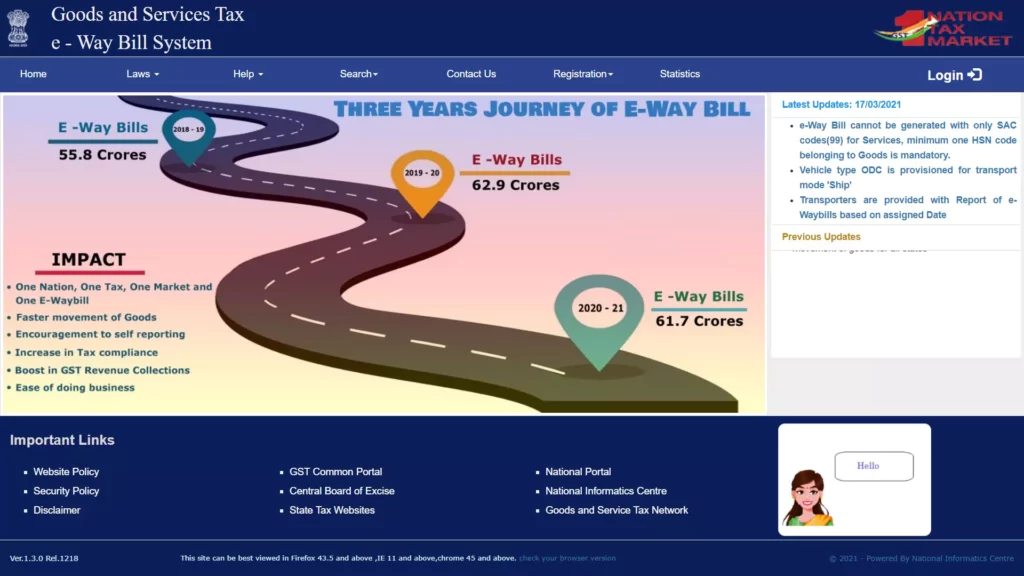
To register for the e-Way Bill system as a first-time GSTIN holder, you can navigate to the e-Way Bill portal and click on the ‘e-way bill Registration’ link available under the registration option. This action will redirect you to the ‘e-Way Bill Registration Form’ displayed on the portal. You can then proceed with filling out the necessary information in the registration form.
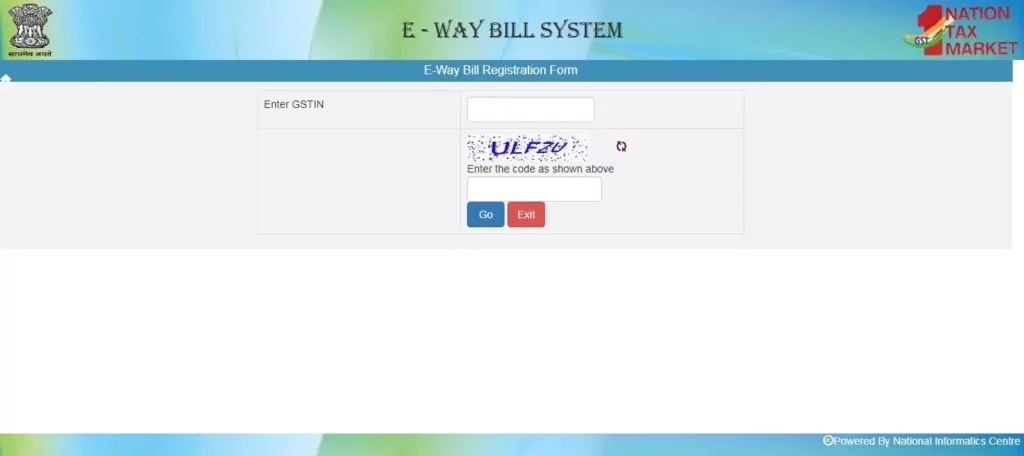
The user is required to enter their GSTIN number and the displayed captcha on the registration form. After entering the details, they can click on the ‘Go’ button to submit the registration request. Upon successful submission, the user will be redirected to the next page, as shown below.
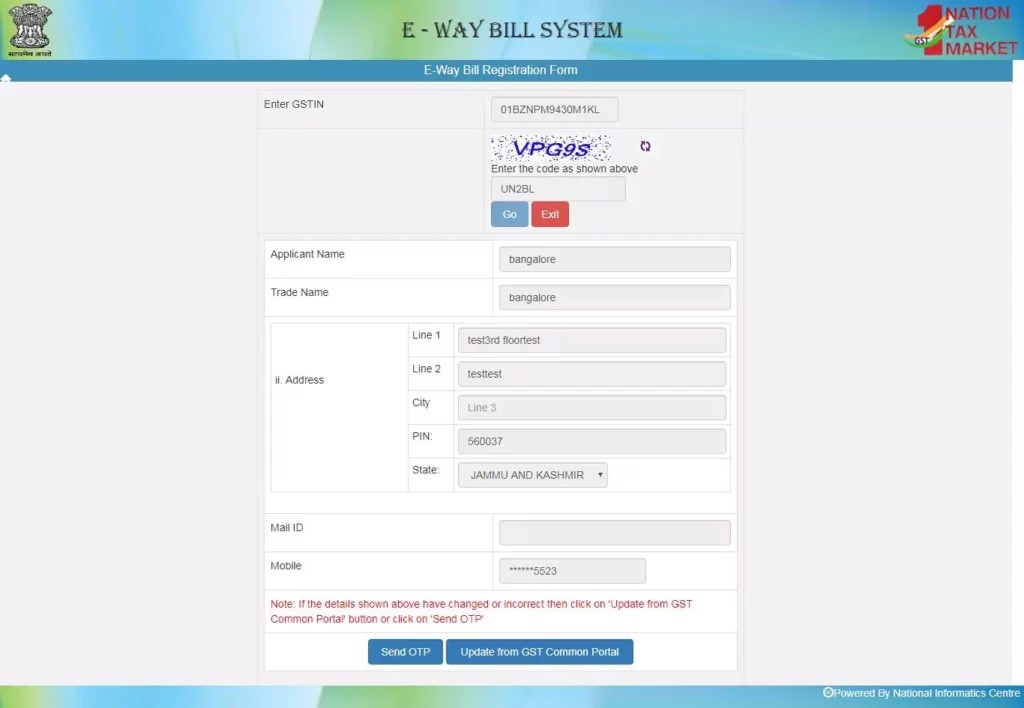
The information provided in the mentioned form such as Applicant name, Trade name, Address, Email ID, and Mobile Number will be automatically populated once the user enters their GSTIN number and the displayed captcha. If any of the details have been changed or are incorrect, the user can click on the ‘Update from GST Common Portal’ button to retrieve the latest data from the GST Common Portal.
To proceed with the registration, the user needs to click on ‘Send OTP’ to receive a One-Time Password (OTP) on their registered mobile number. Once the OTP is received, the user should enter it in the designated field and click on ‘Verify OTP’ to validate it.
Next, the user is required to choose a User ID or username that they intend to use for accessing their account on the e-Way Bill System. The username should be 8 to 15 alphanumeric characters and may include special characters. It should be a unique username that is not already registered in the system. Upon submitting the registration request, the system will validate the entered values and display an appropriate message if there are any errors. If everything is in order, a username with a password will be created and registered with the e-Way Bill System. The taxpayer can then use this registered username and password to access the system and perform the necessary tasks.
3.2 Enrolling by GST un-registered transporters
Unregistered transporters who are not registered in the GST system cannot use the registration option mentioned earlier. Instead, they must enroll in the e-Way Bill system by providing their business details. Once the provided details are authenticated, the system will generate a 15-character Transporter ID and user credentials. The enrollment form will require information such as PAN details, business type, and business place.
The unregistered transporter should access the e-Way Bill portal and select the ‘Enrollment for Transporters’ option to enroll. Upon selecting this option, the system will display the following screen.
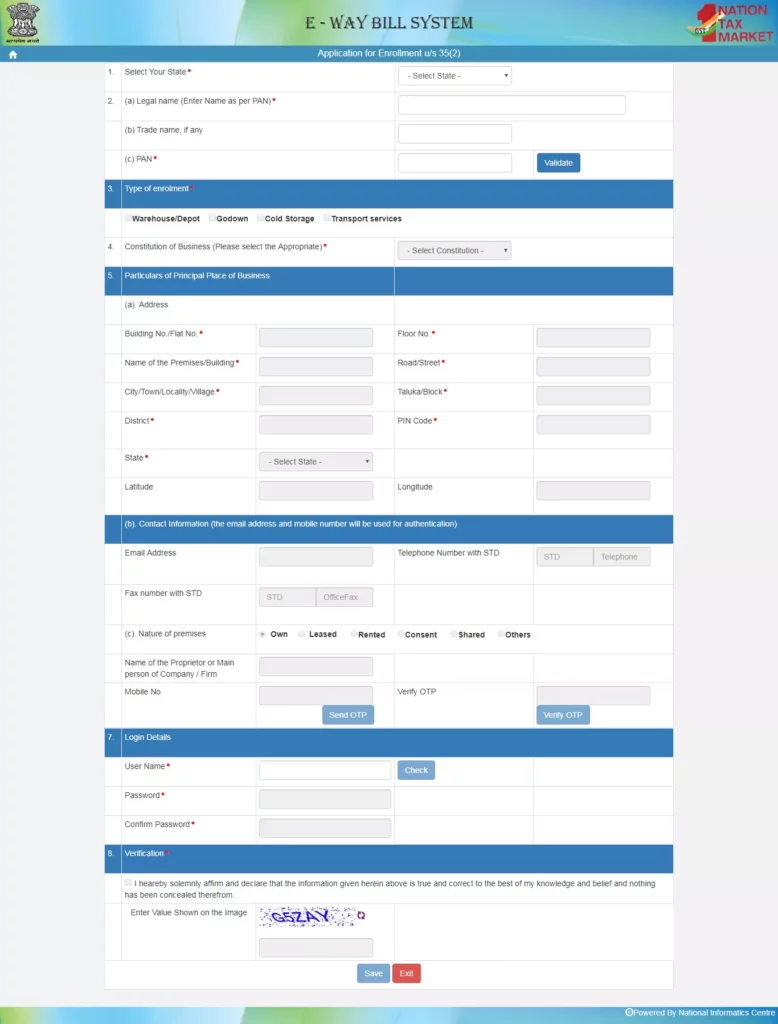
To complete the enrollment process as a transporter, the user needs to follow these steps:
- Select the state and enter the legal name mentioned on the PAN card and the PAN number. Click on the ‘Validate’ button to verify the entered information.
- Choose the type of enrollment and the constitution of your business, such as Partnership, Proprietorship, or Public/Private Limited.
- Provide your business details and contact information.
- Upload the Address and ID proofs (Proof of Address and Proof of Identity) by clicking the respective ‘Upload’ buttons.
- Create a username and password based on your choice, following the rules mentioned for username and password creation.
- Declare the information’s correctness by clicking on the checkbox provided.
- Click the ‘Save’ button to complete the process. The system will generate a 15-digit TRANS ID, which you can provide to your clients. They can enter this TRANS ID in the e-way bill to allow you to enter the vehicle number to move goods.
3.3 Forgot Password
If an e-Way Bill user forgets their password for their username, they can use the “Forgot Password” option by following these steps:
- Click on the “Forgot Password” link on the login page.
- The user will be redirected to a screen where they need to enter the basic information of their GSTIN (Goods and Services Tax Identification Number).
- After entering the GSTIN, click the “Verify” button to proceed.
- If the entered information is successfully verified, the user will receive a new one-time password (OTP) through SMS to their registered mobile number or an email to their registered email address.
- Use this OTP to log in to the system.
- Once logged in, the user can create a new password to replace the temporary OTP.
It is essential to ensure the new password is strong and secure to protect the user’s account.
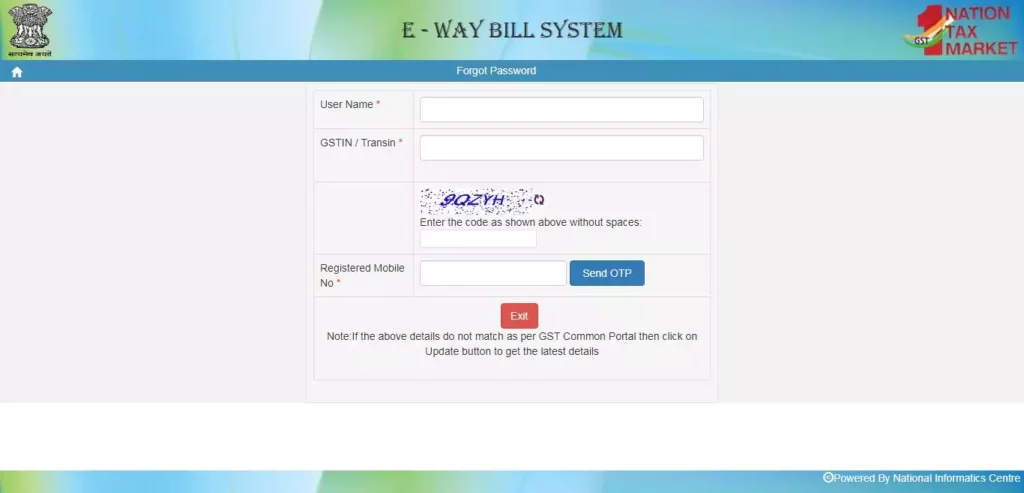
Suppose the details entered do not match the GSTIN data available in the system. An error message will be displayed indicating the mismatch. In such cases, if the taxpayer has recently updated their details on the GST Common Portal, but the changes are not reflected in the e-Way Bill system, they can select the option “Update details from GST CP.”
By selecting this option, the system will fetch the latest data from the Common Portal and update it in the e-Way Bill system. The taxpayer can then try again to receive the new OTP through SMS on their updated mobile number.
This process ensures that the taxpayer’s information is synchronized between the GST Common Portal and the e-Way Bill system, allowing for accurate and up-to-date data for e-Way Bill transactions.
3.4 Forgot User Name
If a user of the e-Way Bill system forgets their username, they can retrieve it by entering their GSTIN in the provided screen. After successful verification of the GSTIN, the system will send the username to the user’s registered mobile number through SMS and also to their email address. This feature lets users quickly retrieve their username in case they have forgotten it, ensuring convenient access to the e-Way Bill system using their correct credentials.
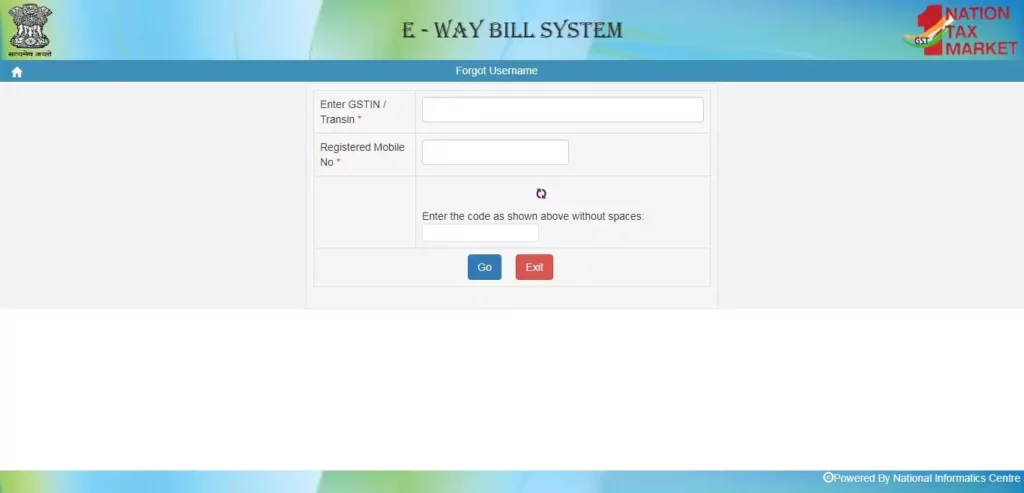
If the details entered by the user do not match the GSTIN data available in the system, an error message will be displayed indicating the mismatch. If the taxpayer has updated their details in the GST Common Portal, but those updates still need to be reflected in the e-way bill system, they can select ‘Update details from GST CP.’ By choosing this option, the system will retrieve the latest data from the Common Portal and update the e-way bill system accordingly.
Once the details have been updated, the user can retry the process to receive the SMS with the new mobile number and the email with the updated information. This ensures that any changes made by the taxpayer in the GST Common Portal are synchronized with the e-way bill system, allowing for accurate and up-to-date information for e-way bill generation and other related processes.
4. Opening the e-Way Bill System
4.1 Logging into e-Way Bill System
To access and log into the e-Way Bill system, users must complete the registration or enrollment process described in Chapter 3. Once registered, users can follow these steps to log into the system:
- Open the e-Way Bill portal in a web browser.
- Enter the username and password created during the registration process.
- Fill in the displayed captcha for verification purposes.
- Upon successful authentication of the credentials, the system will display the main menu of the e-Way Bill System.
Following these steps, users can securely log into the e-Way Bill system and access its features and functionalities.
4.2 Main Menu
The main menu of the e-Way Bill system provides users with various options to navigate and perform operations. Here is an overview of the main menu:
- Dashboard: In the middle of the main menu, the system displays a dashboard that summarizes e-Way Bill activities for the last 7 days specific to the user. This allows users to view and assess their recent e-Way Bill transactions quickly.
- Latest Updates: The system presents the latest updates made in the e-Way Bill system just below the dashboard. Users can access these updates and review any changes or enhancements that have been implemented.
- Main Menu Options: The system presents a list of main menu options on the left side of the menu. These options provide detailed functionalities and operations within the e-Way Bill system. Each option can be selected to navigate to a specific section or feature.
By utilizing the main menu, users can easily navigate through the e-Way Bill system, monitor recent activities, stay informed about updates, and access various tools and functions as per their requirements.
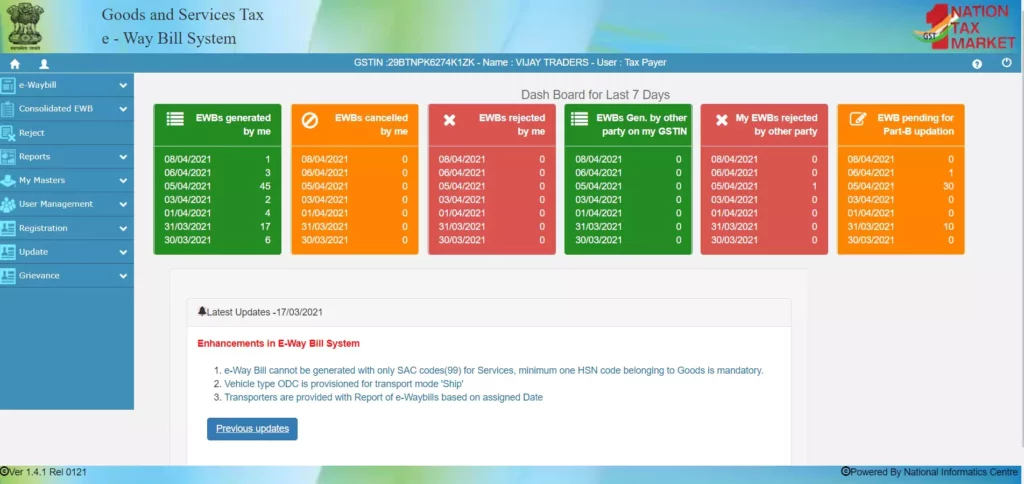
5.1 Generate New:
This option enables users to generate a new e-Way Bill. When the user selects the “Generate New” sub-option under the “e-waybill” menu, they will be presented with the EWB Entry Form. This form lets users enter the necessary details for generating the e-Way Bill.
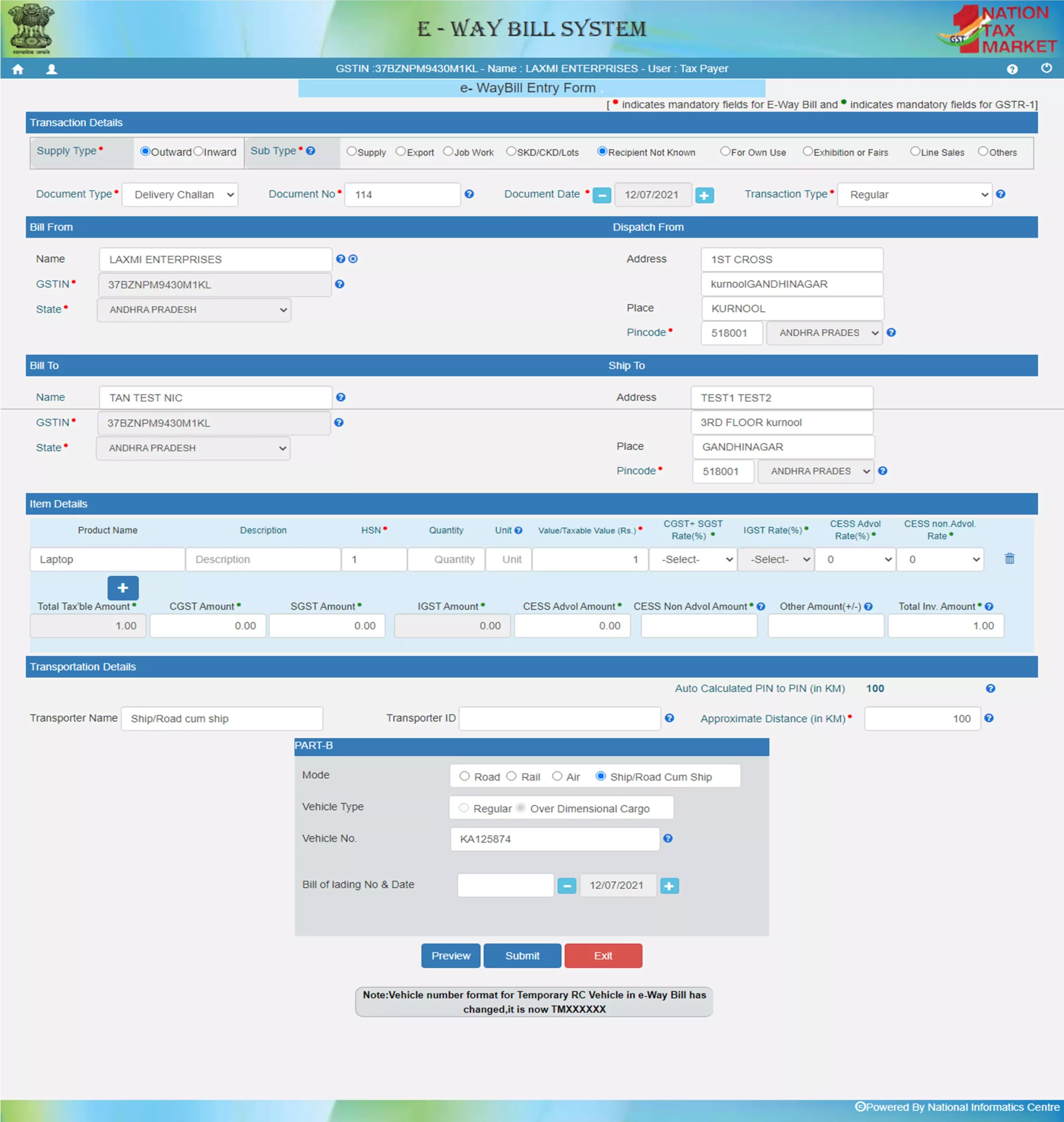
When the user selects the ‘Generate New’ sub-option under the ‘e-way bill’ option, the system displays the e-way bill entry form. This form is used to generate a new e-way bill (EWB). Before initiating the new EWB generation, the user should have the necessary invoice/bill/challan document/details on hand. They should also know the Transporter ID of the transporter through whom the consignment will be moved or have the vehicle details (Part-B) for the shipment.
In the EWB Entry Form, the user must select the type of transaction, either Outward or Inward. The Outward transaction indicates that the user is supplying the goods, while the Inward trade suggests that the user is receiving the goods. Based on the selected transaction type, the system will show the relevant sub-types of transactions. The user needs to choose the appropriate sub-type accordingly.
After selecting the transaction type and sub-type in the ‘Transaction Details’ section, the system will display only the relevant document types in the ‘Document Type’ dropdown, specific to the selected sub-type. The tables below provide more information on the available document types based on the chosen sub-type.
